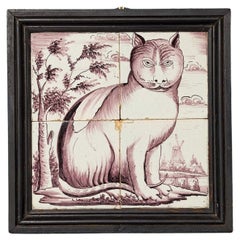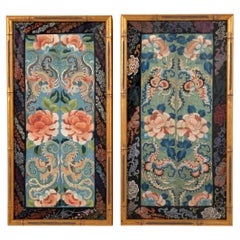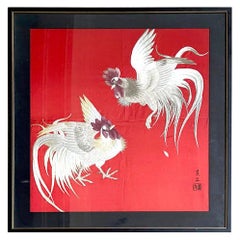Delft Asian Art and Furniture
2
to
2
2
2
2
1
2
2
2
2
2
127
315
139
55
54
Creator: Delft
Antique Framed Delft Tile Panel Depicting a Cat in Landscape
By Delft
Located in Wormelow, Herefordshire
This antique framed tile panel depicting a cat in landscape sourced from the estate of Dame Barbara Mary Quant is quite the find. Displayed in a frame, the tiles form a stunning artw...
Category
Early 19th Century Dutch Antique Delft Asian Art and Furniture
Materials
Clay
Antique Framed Delft Tile Panel Depicting a Bird in Cage
By Delft
Located in Wormelow, Herefordshire
This antique framed tile panel depicting a bird in a decorative cage, sourced from the estate of Dame Barbara Mary Quant, is quite the find. Displayed in a frame, the tiles make a be...
Category
Early 19th Century Dutch Georgian Antique Delft Asian Art and Furniture
Materials
Clay
Related Items
Pair of Framed Fine Chinese Antique Embroidery Panels with Forbidden Knots
Located in Atlanta, GA
A pair of framed antique Chinese embroidery textile panels circa 19th century of Qing Dynasty. Each piece features two mirror-matchin...
Category
19th Century Chinese Qing Antique Delft Asian Art and Furniture
Materials
Brocade, Silk, Giltwood
Framed Japanese Embroidery Textile Panel Rootsters
Located in Atlanta, GA
A matted and framed Japanese silk panel with elaborate embroidery circa late Meiji to Taisho period (1910-30s). On a bright background, two rooster...
Category
Early 20th Century Japanese Japonisme Delft Asian Art and Furniture
Materials
Silk, Wood
Framed Japanese Embroidery Textile Panel Pagoda Scenery
Located in Atlanta, GA
A Japanese silk embroidery landscape scenery panel depicting a Buddhist pagoda and a temple compound set in a forest with towering pines and...
Category
Early 20th Century Japanese Japonisme Delft Asian Art and Furniture
Materials
Metal
Exhibited Framed Fine Chinese Embroidery Silk Panel Qing Dynasty
Located in Atlanta, GA
A very fine embroidered silk panel in giltwood frame originally from the Annette Martin Collection and exhibited at the Chinese Culture Foundation of San Francisco February 8th - Mar...
Category
19th Century Chinese Chinese Export Antique Delft Asian Art and Furniture
Materials
Silk, Giltwood
Framed Antique Chinese Embroidery Panel Qing Dynasty Provenance
Located in Atlanta, GA
An antique Chinese embroidery panel, originally the sleeve band of a robe from Qing Dynasty, circa 19th century. Nicely presented as a...
Category
Mid-19th Century Chinese Chinese Export Antique Delft Asian Art and Furniture
Materials
Silk, Wood
Antique Chinese Embroidered Panel
Located in Saint Ouen, FR
Late 19th century Chinese embroidery with silk and metal on silk foundation, entirely hand embroidered, some damages on metal wires.
Category
Late 19th Century Chinese Chinoiserie Antique Delft Asian Art and Furniture
Materials
Metal
Framed Antique Japanese Embroidered Silk Panel Signed
Located in Atlanta, GA
An exquisite Japanese embroidery piece circa end of 19th-early 20th century of Meiji period. The silk panel depicts an idyllic water scenery, in which three mandarin ducks swim in th...
Category
Early 20th Century Japanese Japonisme Delft Asian Art and Furniture
Materials
Silk, Wood
Framed Japanese Woven Textile Panel with Dragon Meiji Period
Located in Atlanta, GA
A framed Japanese woven textile circa late 19th century of Meiji Period. Likely a fragment of a priest robe or kesa, the multi-paneled textile was finely woven with gold foiled threads that depicts a five-clawed dragon slithering in the clouds and water...
Category
19th Century Japanese Meiji Antique Delft Asian Art and Furniture
Materials
Silk, Wood
Framed Antique Japanese Embroidery Fukusa Panel
Located in Atlanta, GA
A finely embroidered Japanese silk Fukusa panel presented in a beautiful silk-lined giltwood frame (newly framed and glazed), circa late 19th century of Meiji Period. Fukusa is a tra...
Category
Late 19th Century Japanese Meiji Antique Delft Asian Art and Furniture
Materials
Silk, Wood
Framed Antique Japanese Embroidery Fukusa Textile Panel
Located in Atlanta, GA
A Japanese silk Fukusa Panel housed in a gilt frame circa late 19th century of Meiji Period. Fukusa is a traditional Japanese textile art used as a wrap for presenting gifts at important occasions. On the deep blue background, the elaborate embroidery work depicts a historical scene where street vendors selling goods to a royal household or an aristocratic residence. The scene focuses on the activities at the front gate where the couriers and servants were busying carrying the goods in. A peasant with straw coat...
Category
Late 19th Century Japanese Meiji Antique Delft Asian Art and Furniture
Materials
Silk, Wood
Framed Japanese Embroidery Silk Panel Meiji Period
Located in Atlanta, GA
A Japanese silk embroidery Fukusa panel presented in mat and glazed gilt wood frame circa 1890-1910s (end of Meiji Period). The blue silk pane...
Category
1890s Japanese Meiji Antique Delft Asian Art and Furniture
Materials
Silk
Framed Antique Japanese Embroidery Fukusa Panel Takasago Legend
Located in Atlanta, GA
A finely embroidered Japanese silk Fukusa panel presented in a beautiful silk-lined giltwood frame (newly framed and glazed), circa late 19th century of Meiji Period. Fukusa is a traditional Japanese textile art used to wrap and present gifts at important occasions. Depending on the occasion, the panel itself can be a very fine textile art on its own.
On the deep blue background, this elaborate textile art depicts an old couple standing on a bridge with three bystanders, flanked by pine trees with hills afar. The couple is Jotomba (Joo and Uba are their respective names), characters in the Legend of Takasago, one of the oldest Japanese mythologies, who are associated with old pines. The legend goes as: "At Takasago Shrine there is a very old pine tree, the trunk of which is bifurcated; in it dwells the spirit of the Maiden of Takasago who was seen once by the son of Izanagi who fell in love and wedded her. Both lived to a very great age, dying at the same hour on the same day, and since then their spirits abide in the tree, but on moonlight nights they return to human shape to revisit the scene of their earthly felicity and pursue their work of gathering pine needles. His pine tree is called “The Pine of Suminoe” while hers is "Takasago pine".
In Japan, Takasago couple...
Category
Late 19th Century Japanese Meiji Antique Delft Asian Art and Furniture
Materials
Silk, Wood
Delft asian art and furniture for sale on 1stDibs.
Delft asian art and furniture are available for sale on 1stDibs. These distinctive items are frequently made of pottery and are designed with extraordinary care. Many of the original asian art and furniture by Delft were created in the Baroque style in netherlands during the 18th century and earlier. Prices for Delft asian art and furniture can differ depending upon size, time period and other attributes — on 1stDibs, these items begin at $4,896 and can go as high as $4,896, while a piece like these, on average, fetch $4,896.
Questions About Delft Asian Art and Furniture
- What is Delft known for?1 Answer1stDibs ExpertApril 5, 2022Delft is known for its blue ceramic pottery called Delftware. Artisans in the Dutch city began producing the earthenware during the 16th century. In addition, Delft is the home of the 17th-century Dutch Baroque painter Johannes Vermeer. You'll find a range of Delftware on 1stDibs.
- How can I tell if Delft is real?1 Answer1stDibs ExpertApril 5, 2022To tell if Delft pottery is real, look at it under a magnifying glass. Authentic Delftware should show visible brushstrokes, a sign that the pieces have hand-painted images. You can also turn the piece over and look for a crown cross marking with the words Handpainted, Delft Blue, Made in Holland. On 1stDibs, find a collection of expertly vetted Delft pottery.
- When were Delft tiles made?1 Answer1stDibs ExpertMarch 22, 2022Delft tiles were made during the 17th and 18th centuries. The term refers to earthenware tiles with tin-glaze finishes that were meticulously hand-painted by artisans living in the city of Delft in what is now the Netherlands. Find a selection of Delft tiles on 1stDibs.
- Is Delft Blue still made?1 Answer1stDibs ExpertApril 5, 2022Delft Blue is in fact still made today. There is one factory left, the Royal Dutch, which has been in operation since 1653. It continues to make delft blue using the traditional methods. You’ll find a variety of Delft blue products from some of the world’s top sellers on 1stDibs.
- 1stDibs ExpertApril 5, 2022Yes, Delft tiles are still being produced. Delft pottery, also known as Delftware or Delft Blue, refers to a tin-glazed earthenware crafted in the city of Delft in the Netherlands. Delftware is highly coveted due to the intricate nature of the design and is a favorite among home decor enthusiasts. Shop a wide range of authentic Delftware on 1stDibs.
- 1stDibs ExpertFebruary 22, 2021Delftware often has a maker's mark on the base or back of the item consisting of letters or figurative symbols to show where the item was manufactured. Today markings will say hand-painted in Holland as well as the phrase Delft blue in Dutch or English.



